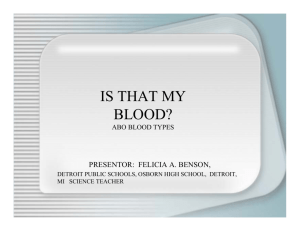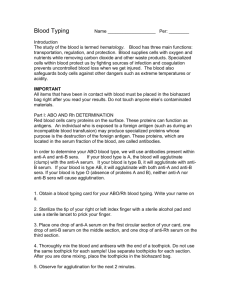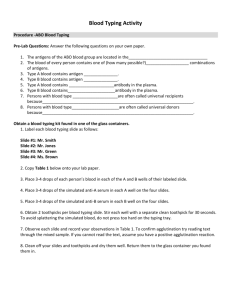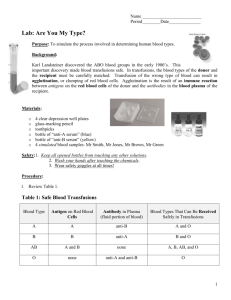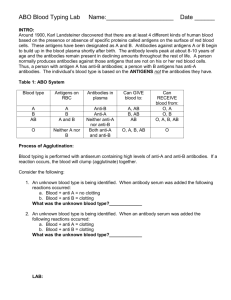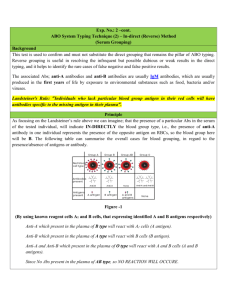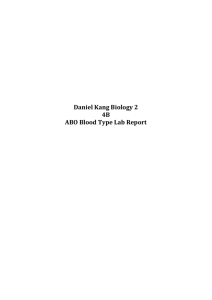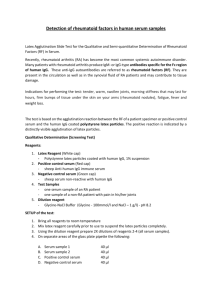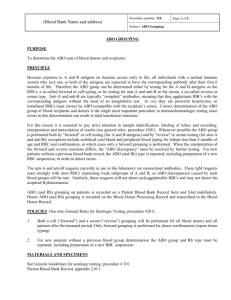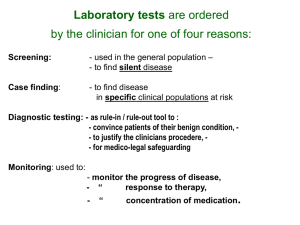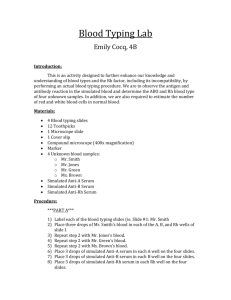ABO DISCREPANCIES A
advertisement
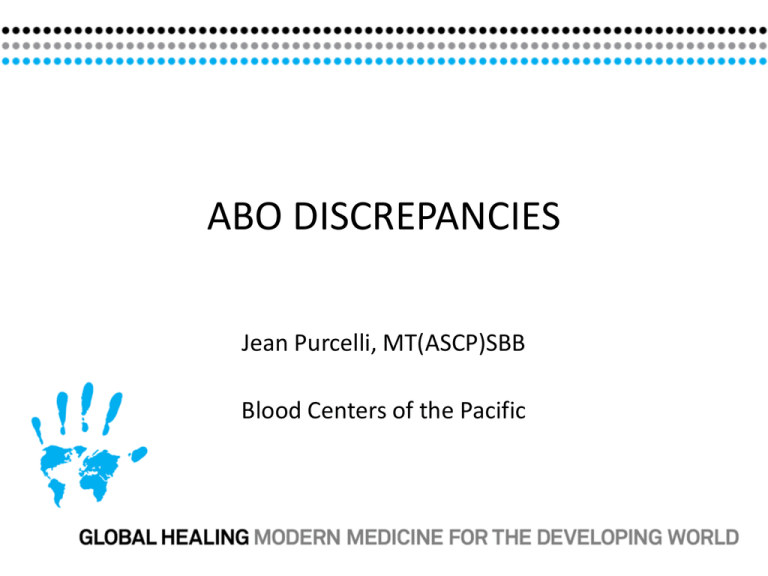
ABO DISCREPANCIES Jean Purcelli, MT(ASCP)SBB Blood Centers of the Pacific • ABO discrepancies occur because of: • Intrinsic problems with the red cells or the serum. • Test related problems—slide vs. tube • Technical errors. Intrinsic red cell problems • Weaker subgroups of A and B or AB such as A2, Ax, A3, A2B and subgroups of B. • Variant A or B genes such as B(A). Must be differentiated from a subgroup of AB. • A patient who has had a bone marrow transplant or an A or B recipient recently transfused with group O red cells. Intrinsic problems Intrinsic red red cell cell problems • Acquired with infections AcquiredB.B.Usually Usuallyassociated associated with infections from from GI GI(gastro-intestinal) (gastro-intestinal)bacteria bacteria • Polyagglutinable state. The red cells are • Polyagglutinable state. The cellssource are antiunexpectedly agglutinated by red human unexpectedly agglutinated by human source A and Anti-B. Not seen with monoclonal antisera. anti-A and Anti-B. Not seen with monoclonal antisera. • Potent cold agglutinins Intrinsic problems in the serum Anti- A or –B is not usually detectable until 4-6 months of age. Any reactivity is usually maternal IgG forms of anti-A or –B. A2 or weaker subgroups of A or AB may produce anti-A1. Anti-A1 will react with A1 cells but not A2 or O cells. Allo-antibodies such as anti-M,-N,-P1, Lea or Leb May react at IS (immidiate spin)or RT(room temperature) and react with the A or B cells. Intrinsic problems with the serum • Abnormal concentrations of proteins or infusion with high molecular weight plasma expanders may show aggregation that is difficult to distinguish from true agglutination. • Immunodeficient patient, due to disease or therapy may have decreased levels of anti-A or –B. Intrinsic problems with the serum • Infusion of large volumes of compatible but not type specific plasma. • Bone marrow transplants with compatible but dissimilar ABO groups. Example: a group A individual who receives group O marrow will produce circulating O cells, but produce only antiB in the serum. • Potent cold aggutinins. ABO seenwith withtest test ABOdiscrepancies discrepancies seen related problems problems related • Abnormal proteins, infusion of macromolecular solutions or improperly collected cord blood (contaminated with Wharton’s jelly) may cause false agglutination of cells. This is especially true when the cells are resuspended in serum which is usual for slide typing. Problems with the test system •Serum • Serummay maycontain containantibodies antibodiestotothe thedyes dyesused toused colorto anti-A anti-B give colorand anti-A and (USA) anti-Bwhich (USA)may which false with serum-suspended maypositives give false positives with serum-cells in the slide test. suspended cells in the slide test. Resolving AB0 discrepancies • Repeat the tests after washing patient cells and the A and B cells several times. • Analyze the problem: 1. Unexptected Unexptected ++ororunexpected unexpected––results? results? 2. Whatisisunusual 2.What unusualorordifferent? different? 3. Doyou 3.Do yousee seespontaneous spontaneousagglutination? agglutination? Resolving ABO discrepancies • If the serum is unexpectedly positive, does the agglutination look like rouleaux? Use salinereplacement technique. • Should you try to prove anti-A1 in an A2 person. Type patient cells with anti-A1 lectin. • Test the serum with screening cells, and another set of A1 and A2 cells. Resolving ABO dicrepancies • Is there strong hemolysis in reverse grouping tubes? tubes? Add Add another another drop drop of of appropriate appropriate cell cell and and centrifuge centrifuge again. again. • • • • Is the serum typing unexpectedly negative? Is the serum typing unexpectedly negative? Add several more drops of serum to all reverse Add several more drops ofthe serum to all reverse grouping tubes, incuding 3 O screening grouping tubes, 3 O screening cells and an autoincuding control. the Incubate at RT or cells and an auto control. Incubate at RT or colder. colder. Resolving ABO discrepancies • If the discrepancy cannot be resolved , a patient should be transfused with group O red cells of the appropriate Rh type. • A donor units may not be labelled or released for transfusion and should be discarded. • Refer to examples of paper ABO discrepancies • And serological resolution
